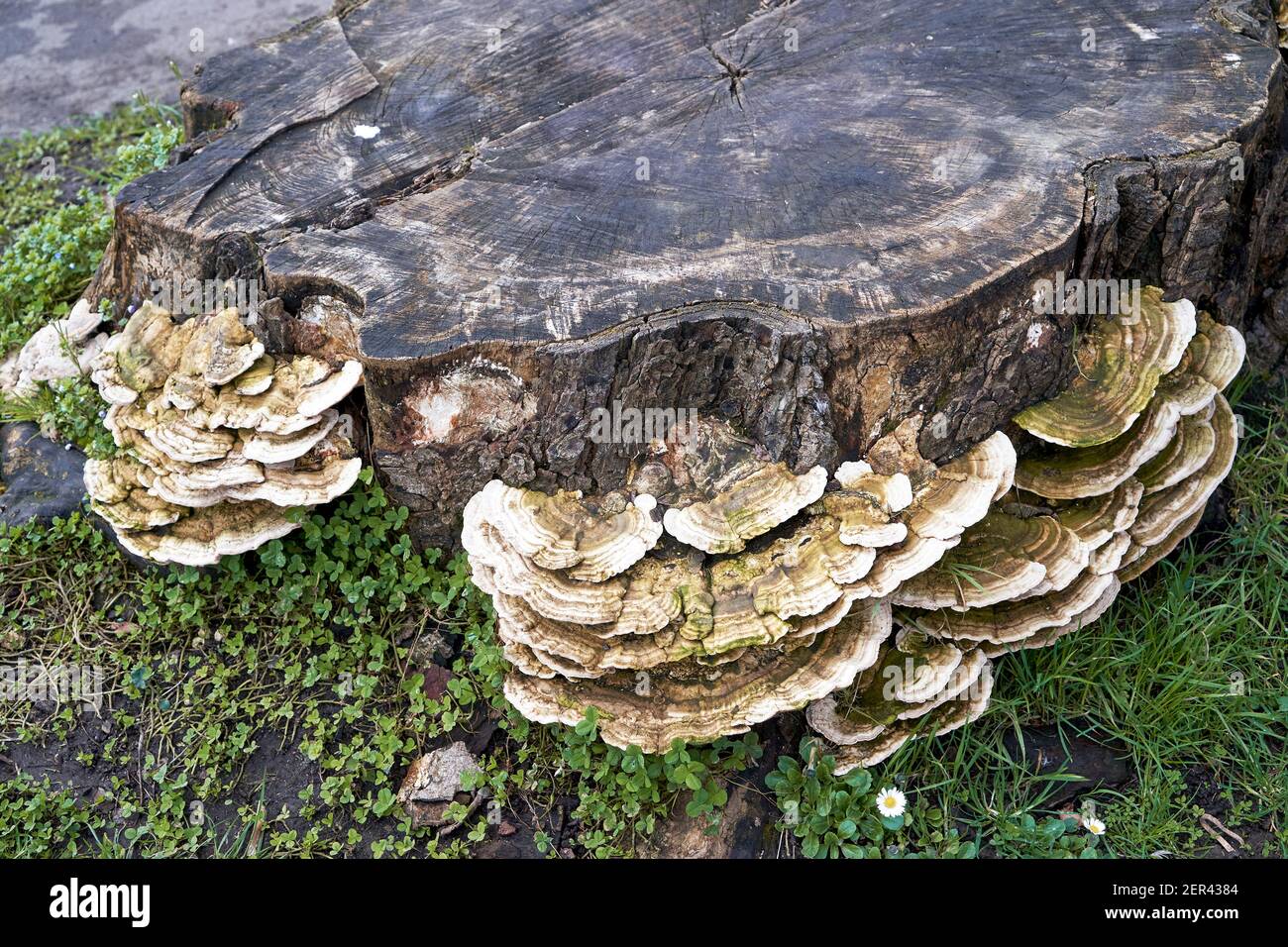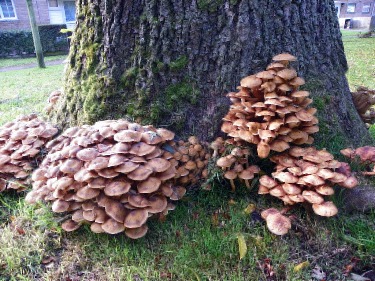Go for a walk in the woods and you’ll see plenty of fungi growing on trees. Any old stump or deadfall is a potential home for a crop of them, whether it’s mushrooms or plate-like bracket fungus. The many fungi that appear on dead wood are an essential part of nature, helping to process old trees back into the food chain. However some of them can be a serious problem for gardeners.
Fungi are unusual organisms. We usually think of them as plants, but they’re not; they’re a whole separate type of life. Biologists class living things in five “kingdoms”; bacteria, protists (an assortment of single-celled organisms), plants, animals – and fungi. In many ways fungi are more like animals than plants, because instead of manufacturing their own food from carbon dioxide and sunlight they digest parts of other organisms.
Fungi come in many shapes and sizes, with the large ones being the most conspicuous. Often a fungus is like an iceberg – what’s visible is only a small part of what’s there. If you see a mushroom or puffball you might think that’s the whole thing, but in fact it’s just a fruit. Its purpose is to grow, then scatter, the spores that will grow into more fungi, and it won’t last for long. The actual organism it’s growing from is a network of threads buried just below the surface, and this network is the feeding, growing part of the fungus. In the case of a mushroom of puffball it’s nourishing itself on decaying plant matter in the soil. Other species will be feeding on a dead, or living, tree.
Stumbling upon fungus growing on a tree stump in your yard can be puzzling. The spongy orange or brown mushroom-like growths appear fascinating but also raise questions. Is the fungus harmful? Should you remove it? This comprehensive guide examines the common causes, identification, removal, and prevention of fungi on tree stumps.
Why Does Fungus Grow on Tree Stumps?
Fungi thrive on decaying organic matter, so a tree stump is prime real estate When a tree is cut, the remaining stump still contains nutrients like lignin, cellulose, proteins, sugars, and starches The fungi release enzymes to break down the tough woody material in the stump and extract nutrients as they decompose the wood.
The main factors that lead to fungi colonizing and feeding on a tree stump are:
-
Moisture: Fungi need damp conditions to grow. Stumps retain moisture that fungi require.
-
Shade: Less sunlight keeps stumps from drying out, creating the perfect humid habitat for fungi.
-
Nutrients: The wood contains organic compounds that fungi consume as food.
-
Damage Cuts and wounds in the stump provide entry points for spores
-
Time: It takes weeks or years for fungi to establish extensive networks in the stump as it slowly decays.
If you have a tree stump, chances are fungi will eventually sprout on it as they break down the woody material.
Identifying Fungi on Tree Stumps
There are many types of fungi that can grow on tree stumps. Some common varieties include:
-
Turkey tail: Colorful bands of brown, gray, and orange in a leaf-like, thin shape.
-
Reishi: Large with a reddish-orange fan shape and woody texture.
-
Artist’s conk: A bracket fungus with a brown top and distinctive white underside.
-
Oyster mushroom: Clustered together in overlapping grayish caps.
-
Chicken of the woods: Bright orange or yellow shelf-like clusters.
-
Wood ear: Brown, ear-shaped, and jelly-like in texture.
-
Coral fungus: Branching arms resembling aquatic coral, often bright colors.
Use the mushroom’s shape, texture, color, and stump location to accurately identify the species present. Many are harmless, but some may indicate disease.
Are Fungi on Tree Stumps Harmful?
In most cases, fungi naturally sprouting on tree stumps are not harmful:
-
They accelerate decomposition and nutrient recycling.
-
Many edible types like oyster mushrooms grow on stumps.
-
They show the stump is decaying and slowly breaking down.
-
Tree defenses prevent spread to living trees.
However, certain fungi are potentially concerning:
-
Shelf fungi could mean root rot infecting tree health.
-
Large clusters indicate advanced decay, which can destabilize trees.
-
Lawn mushrooms could sicken pets if ingested.
Monitor for changes and contact an arborist if you notice issues with nearby trees. Prompt stump removal helps limit fungal propagation.
How to Safely Remove Fungus from a Tree Stump
If fungi are taking over a tree stump in your yard, here are some safe removal methods:
-
Physical removal: Gently scrape off mushrooms with a trowel, putty knife or wire brush.
-
Saltwater spray: Mix 1 cup salt per gallon of water and spray the stump to dry out fungi. Reapply after rain.
-
Vinegar spray: Use full strength household vinegar to retard growth and kill fungi.
-
Bleach solution: A 8:1 water/bleach mixture kills fungal spores on contact. Rinse off after 20 minutes.
-
Borax powder: Sprinkle this natural antifungal on the stump and inside holes. Reapply after rain.
-
Remove the stump: Grinding down or digging out the stump eliminates the food source.
For severe fungal growth, stump removal is the most effective long-term solution. Otherwise, commit to reapplying chemical sprays or trying different remedies.
How to Prevent Fungus on Tree Stumps
To proactively prevent fungi growth on tree stumps:
-
Cut stumps as low to the ground as possible since fungi grow slower on lower stumps.
-
Apply a wood sealant like lacquer right after cutting to repel moisture and prevent spore germination.
-
Cover fresh stumps with a plastic tarp to block spores and retain moisture.
-
Remove the stump within 3-6 months before extensive fungal networks establish.
-
Treat surrounding trees with fungicides if trying to prevent spread from an infected stump.
Eliminating stumps completely is ideal, but early protection is key for any that remain.
When to Worry About Fungi on Tree Stumps
Consult an arborist if you notice:
-
Large clusters at the base or on roots.
-
Signs of infection in nearby trees like base mushrooms or oozing bark lesions.
-
Thinning grass around the stump, indicating possible soil contamination.
-
Mushrooms far from the stump, signaling extensive underground mycelium.
-
Any unidentified varieties.
Prompt stump removal and fungicide use helps contain harmful spread. Don’t delay treatment if disease symptoms arise in your yard’s landscape.
While fungi decomposing a tree stump are natural, monitor for any indications of issues. With quick removal and preventative spraying, most fungi are harmless. But catching problems early prevents extensive damage to your property’s precious trees and plants.

Common Large Fungi That Grow On Trees
Chicken of the woods – Grows on the trunks of oak, willow, yew, cherry and sweet chestnut in summer and fall. Young plates are edible.
Oak bracket – A parasite of oaks, growing around the base of the trunk. Eventually the trunk can snap, bringing down the whole tree.
Birch polypore – Usually grows on dead birches but can also infect live trees. When it does it usually kills them.
Honey fungus – Infects the roots or trunks of most tree species and produces dense masses of mushrooms. Causes very aggressive rot and is considered one of the worst tree parasites. Can send out threads under the soil for several yards, and attack new trees. Edible when cooked, but raw ones are mildly toxic.
Types of Tree Fungus
 If a fungi feeds on stumps or fallen branches it’s not a major concern for gardeners, but ones that grow as parasites on living trees can be a more serious problem. Bracket fungi are common on older trees, and often people don’t bother with them. Some are even valuable; the oyster mushroom is a common parasite on most broad-leaved trees, while porcelain fungus grows on beech, and both of these are edible. They can be very damaging though.
If a fungi feeds on stumps or fallen branches it’s not a major concern for gardeners, but ones that grow as parasites on living trees can be a more serious problem. Bracket fungi are common on older trees, and often people don’t bother with them. Some are even valuable; the oyster mushroom is a common parasite on most broad-leaved trees, while porcelain fungus grows on beech, and both of these are edible. They can be very damaging though.
Occasionally these fungi infect a seed and linger in the tree’s sapwood as it grows, but the fungus itself doesn’t become active until the tree is diseased or stressed. Others establish themselves where a tree has been damaged – on the end of a broken branch, perhaps, or through a gouge in the bark. A few species form a beneficial relationship with their host tree; the fly agaric, the classic white-spotted red toadstool, grows around the roots of birch or pine and protects them against parasitic species. Others will damage, and can kill, a tree.
Most tree fungi consume decaying wood, but there isn’t a lot of that on a healthy tree. Some species cheat by excreting chemicals that cause rot in the surrounding wood. That gives the fungus a steady supply of food but eventually the infected branch or trunk will become brittle, and can break suddenly. Unfortunately you can’t solve the problem by just cutting away the visible mushrooms or plates, because the heart of the fungus is those threads running through the bark and sapwood. The most reliable solution is to prune the infected parts with a disinfected saw, then dispose of them far from the tree. You can also spray the tree with a fungicide, such as Bordeaux mixture. Regular sprays when buds are swelling, and again when the tree flowers, can help prevent infection.
Could an old dead tree root be causing yard fungus?
FAQ
How to get rid of fungus on a tree stump?
-
Identify the type of fungus:Different fungi require different treatments. If you can identify the type, SavATree provides a helpful resource for tree fungus identification.
-
Determine the extent of the infection:Is it localized to the stump, or has it spread to the surrounding soil or other parts of the tree?
-
Consider the health of the tree:A weakened tree is more susceptible to fungal infections, Alberta Arborists explains.
What fungus grows on stumps?
Stereum species
This group of fungi are commonly found on dead trees, branches, and stumps but rarely cause serious decay in living trees. They can cause heart rot on trees wounded by pruning or bark injury. The annual fruiting bodies are thin, leathery, and bracket-like, lack stalks, and are 1 inch or more across.
How do you treat tree root fungus?
If a tree is significantly infected, the best way to control it from spreading the disease to healthier trees is to remove it entirely. Chemicals, such as chloropicrin or methyl bromide, won’t completely cure the disease but can reduce the level of the infection.
Can tree fungus be harmful to humans?
The good news is tree fungi do NOT generally transmit to humans.Jan 10, 2019
